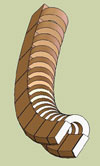"Mind the Gap"
 I have to admit that at the moment, visits to our capital city are few and far between. The heart of business and finance maybe the place where many a motor sport deal is done, but the real action as far as I am concerned, is always in the workshop or on the track. But on those very occasional sojourns when needs must and when using the underground ‘tube’, I’m always reminded of one critical aspect of the piston ring. You see, at many of the stations when the train is just coming to a halt and doors open, the station announcer may call “mind the gap.” And lost in my own little world my mind immediately reverts to the void somewhere deep inside the engine, where the two ends of the piston ring meet. Getting this optimally correct in the top compression ring takes a lot of thought and much effort.
I have to admit that at the moment, visits to our capital city are few and far between. The heart of business and finance maybe the place where many a motor sport deal is done, but the real action as far as I am concerned, is always in the workshop or on the track. But on those very occasional sojourns when needs must and when using the underground ‘tube’, I’m always reminded of one critical aspect of the piston ring. You see, at many of the stations when the train is just coming to a halt and doors open, the station announcer may call “mind the gap.” And lost in my own little world my mind immediately reverts to the void somewhere deep inside the engine, where the two ends of the piston ring meet. Getting this optimally correct in the top compression ring takes a lot of thought and much effort.
As we are all aware, the top compression ring is the main barrier to the combustion gases escaping into the crankcase and the simple practicalities of the design require it to be not only circular to match the cylinder bore, but also capable of being fitted into the piston groove with the minimum of complexity. Thus the familiar circular ring with a gap is almost ubiquitous and ring manufacturers will advise that this gap when fitted should be nominally something like 0.005 inches per inch diameter of the bore. Too large then the combustion gas will escape, exhaust gas blow-by will increase, and engine horsepower as a direct consequence will suffer. The most obvious solution is therefore to keep this gap to a minimum.
But we, as development engineers know it isn’t always that easy. In performance engines, reducing this end face clearance can bring with it other issues.
By their very nature, competition engines tend to run harder for longer periods. The heat flow around the piston top land is therefore much greater and the temperature around the piston ring much higher. In the cylinder liner, particularly near the top, temperatures are to a certain extent constrained by the presence of the cooling water and as such the temperature gradients in this zone can be considerably increased. Add to this the effect of the occasional detonation cycle if, as a competition unit it is ‘tuned’ to the limit, and we have all the ingredients for the rings to expand much more than normal, filling the void and eventually butting together. At this point any further increase in temperature as a result of say, a slight weakening of the mixture or increased detonation, can have a devastating effect producing more friction followed by the breakdown of the lubricant film, eventually leading to scuffing on both the cylinder bore and ring outer face. In extreme cases, rings will seize, resulting in catastrophic damage when the piston top land breaks away.
But if there is one thing that I have learned over the years, it is that engines don’t always react as they should. Reducing ring gaps, particularly those of the top ring should, in theory, minimise blow-by and generate just that extra little bit of power. However if combustion is marginal and detonation, however slight a possibility, then it might be better to stay on the safe side and maintain or even slightly increase them. But whatever you do, follow the manufacturers guidance.
Oh and when getting off the ‘tube’, do be careful!
Written by John Coxon.